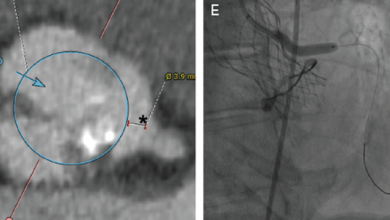Search results
Author(s):
Ulrich Schäfer
Added:
3 years ago
As the field of interventional cardiology has grown, so too has interest in mitigating severe adverse outcomes such as stroke. Unfortunately, the risk of stroke is increased by many underlying disease conditions (atrial fibrillation, patent foramen ovale, carotid artery disease and other vascular disease affecting brain perfusion, etc.), making clear differentiation between cardiac intervention…
View more
Anticoagulation after TAVI
Author(s):
Antonio Greco
,
Davide Capodanno
Added:
3 years ago
Article
Author(s):
Florian Hecker
,
Mani Arsalan
,
Thomas Walther
Added:
3 years ago
Transcatheter aortic valve replacement (TAVR) has become the default treatment option for high-risk patients with aortic stenosis (AS) and, based on heart team discussion, an alternative to surgical aortic valve replacement (SAVR) in intermediate-risk patients.
TAVR has led to a paradigm shift in the basic therapeutic principle to treat AS: calcifications, in some patients quite excessive, are…
View more
Chimney Stenting During TAVI
Author(s):
Liesbeth Rosseel
,
Michael Rosseel
,
Brian G Hynes
,
et al
Added:
3 years ago
Article
Frontiers of Patent Foramen Ovale Closure and New Design Improvements - A Review of the Literature
Author(s):
Raquel del Valle-Fernández
,
Carlos E Ruiz
Added:
3 years ago
Article
Author(s):
Antonio Greco
,
Claudio Laudani
,
Carla Rochira
,
et al
Added:
1 year ago
Author(s):
John A Kaufman
Added:
3 years ago
Optional vena cava (VC) filters are filtration devices that can be placed percutaneously into the inferior VC (IVC) to provide protection from pulmonary embolism (PE). These devices can be either removed (retrievable filters) or altered in some way to no longer function as a filter while remaining in the IVC (convertible filters), although the latter are not yet commercially available. The…
View more
Author(s):
Jennifer Franke
,
Nina Wunderlich
,
Horst Sievert
Added:
3 years ago
As an intra-cardiac right-to-left shunt, the patent foramen ovale (PFO) has gained attention over the last two decades because of its potential pathological importance in a number of disease processes including stroke, peripheral embolism, systemic oxygen desaturation (i.e. hypoxaemia) and migraine headaches. Percutaneous PFO closure, using a double-umbrella Clamshell device (Bard, USCI,…
View more
Author(s):
Apostolos Tzikas
,
Darren Mylotte
,
Martin Bergmann
Added:
3 years ago
Atrial fibrillation (AF), the most common arrhythmia, is associated with a significantly increased risk of morbidity and mortality due to a fivefold increase in the frequency of thromboembolic stroke.1 The gold standard treatment for the prevention of AF-related thromboembolism is oral anticoagulation (OAC), based on an individualised patient risk assessment with either the CHADS2 or the CHA2DS2…
View more
Peripartum CS and MCS
Author(s):
Giulia Botti
,
Sharmaine Thirunavukarasu
,
Francesca Ziviello
,
et al
Added:
4 months ago
Article














 « First
« First